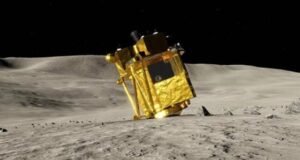
People as far away as San Francisco, Sacramento, Phoenix and Reno, Nevada, posted photos of the Falcon 9 rocket’s launch and return on October 7 night. It was the first time SpaceX landed the first-stage booster back at its launch site at Vandenberg Air Force Base, about 130 miles (210 kilometres) northwest of Los Angeles.
The Air Force warned residents on the Central Coast that they might see multiple engine burns by the first stage and hear one or more sonic booms as it returned. But many far beyond the region were taken by surprise when the launch illuminated the sky, wondering what the otherworldly looking sight was. Some speculated it was a comet or an alien aircraft.
“Something exploded in the sky west of Phoenix,” Laura Gadbery wrote on Twitter. “Anyone catch it or know what it was?”
Lloyd Lawrence, another user in Phoenix — about 490 miles (790 kilometres) away from the launch site — said he was driving on Interstate 10 when he saw the launch and “couldn’t believe my eyes.”
“I wondered who was holding the gigantic flashlight in the sky,” he wrote. Others in Reno, Nevada — about 340 miles away (550 kilometres) — also saw the galactic wonder.
Jill Bergantz Carley wrote: “OK Twitter, what the heck is this #UFO #brightlight #plume-a-licious thing we just saw in the sky above #Reno — it radiated beams of light!”
Debi Hammond wrote: “Strangest thing I’ve ever seen in the sky. Anyone know what this is?”
Californians from Los Angeles to Sacramento — about 270 miles (435 kilometres) from the launch site — also posted their confusion. Los Angeles Mayor Eric Garcetti was among those trying to clear up the speculation, tweeting a photo of the launch and writing: “Nope, definitely not aliens.”
Those who knew they were watching a satellite launch posted videos they captured of the stunning spectacle, including one taken over the downtown Los Angeles skyline and a timelapse from Kern County.
The primary purpose of the SpaceX mission was to place the SAOCOM 1A satellite into orbit, but SpaceX also wanted to expand its recovery of first stages to its launch site at Vandenberg. SpaceX had previously flown first-stage rockets back to land after Florida launches but had not done so on the West Coast.
SpaceX also has successfully landed Falcon 9 first stages on so-called drone ships off the coasts of Florida and California, all as part of its effort to decrease the cost of space launches by reusing rockets rather than allowing them to fall into the ocean.
The satellite is the first of two for Argentina’s space agency, the Comision Nacional de Actividades Espaciales, and will work in conjunction with a constellation of Italian space agency satellites. Its acronym is short for Satelite Argentino de Observacion Con Microondas.
SAOCOM 1A carries a high-resolution instrument called a synthetic aperture radar that will be used for emergency management during disasters and for land monitoring. The second satellite will be SAOCOM 1B.
 Weekly Bangla Mirror | Bangla Mirror, Bangladeshi news in UK, bangla mirror news
Weekly Bangla Mirror | Bangla Mirror, Bangladeshi news in UK, bangla mirror news






